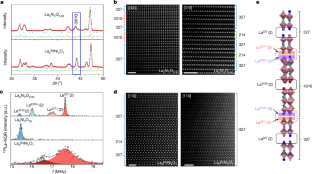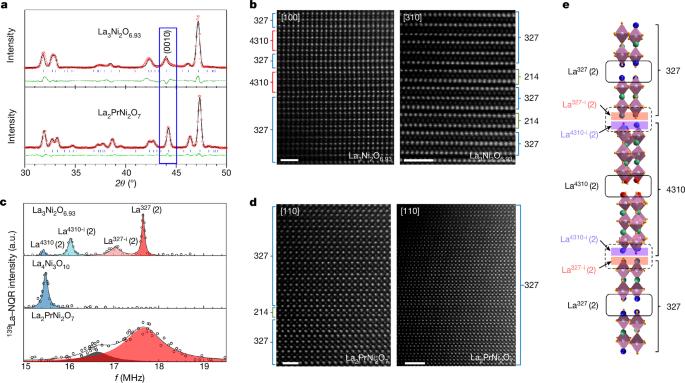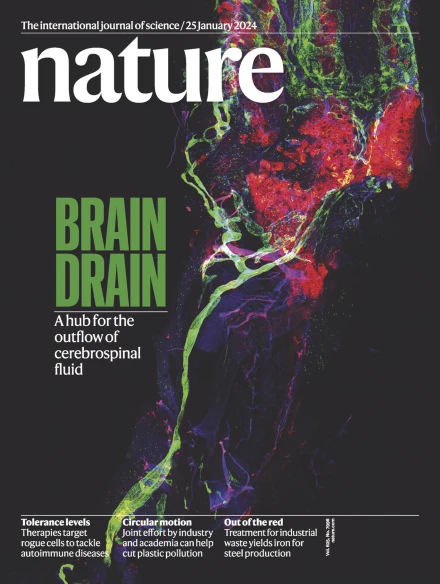Bulk high-temperature superconductivity in pressurized tetragonal La2PrNi2O7
IF 50.5
1区 综合性期刊
Q1 MULTIDISCIPLINARY SCIENCES
引用次数: 0
Abstract
The Ruddlesden–Popper (R–P) bilayer nickelate, La3Ni2O7, was recently found to show signatures of high-temperature superconductivity (HTSC) at pressures above 14 GPa (ref. 1). Subsequent investigations achieved zero resistance in single-crystalline and polycrystalline samples under hydrostatic pressure conditions2–4. Yet, obvious diamagnetic signals, the other hallmark of superconductors, are still lacking owing to the filamentary nature with low superconducting volume fraction2,4,5. The presence of a new 1313 polymorph and competing R–P phases obscured proper identification of the phase for HTSC6–9. Thus, achieving bulk HTSC and identifying the phase at play are the most prominent tasks. Here we address these issues in the praseodymium (Pr)-doped La2PrNi2O7 polycrystalline samples. We find that substitutions of Pr for La effectively inhibit the intergrowth of different R–P phases, resulting in a nearly pure bilayer structure. For La2PrNi2O7, pressure-induced orthorhombic to tetragonal structural transition takes place at Pc ≈ 11 GPa, above which HTSC emerges gradually on further compression. The superconducting transition temperatures at 18–20 GPa reach $${T}_{{\rm{c}}}^{{\rm{onset}}}=82.5\,{\rm{K}}$$ and $${T}_{{\rm{c}}}^{{\rm{zero}}}=60\,{\rm{K}}$$ , which are the highest values, to our knowledge, among known nickelate superconductors. Importantly, bulk HTSC was testified by detecting clear diamagnetic signals below about 75 K with appreciable superconducting shielding volume fractions at a pressure of above 15 GPa. Our results not only resolve the existing controversies but also provide directions for exploring bulk HTSC in the bilayer nickelates. Bulk high-temperature superconductivity observed in pressurized tetragonal La2PrNi2O7 was testified by detecting clear diamagnetic signals below about 75 K with appreciable superconducting shielding volume fractions at a pressure of above 15 GPa.


加压四方 La2PrNi2O7 中的体高温超导性
最近发现 Ruddlesden-Popper(R-P)双层镍酸盐 La3Ni2O7 在 14 GPa 以上的压力下显示出高温超导(HTSC)的特征(参考文献 1)。随后的研究发现,在静水压力条件下,单晶和多晶样品的电阻为零2,3,4。然而,由于超导体积分数较低的丝状性质,超导体的另一个标志--明显的二磁信号仍然缺乏2,4,5。新的 1313 多晶体和相互竞争的 R-P 相的存在,阻碍了对 HTSC 相的正确识别6,7,8,9。因此,实现块状 HTSC 和确定起作用的相是最突出的任务。在此,我们在掺杂镨(Pr)的 La2PrNi2O7 多晶样品中解决了这些问题。我们发现,用 Pr 替代 La 能有效抑制不同 R-P 相的相互生长,从而形成近乎纯净的双层结构。对于 La2PrNi2O7,压力诱导的正方到四方结构转变发生在 Pc ≈ 11 GPa 时,超过这一温度,进一步压缩时会逐渐出现 HTSC。18-20 GPa时的超导转变温度达到了({T}_{/rm{c}}}^{/rm{onset}}=82.5/{/rm{K}}/)和({T}_{/rm{c}}}^{/rm{zero}}}=60/{/rm{K}}/),据我们所知,这是已知镍酸盐超导体中的最高值。重要的是,通过在大约 75 K 以下检测到清晰的二磁信号,以及在 15 GPa 以上的压力下检测到可观的超导屏蔽体积分数,验证了块状 HTSC。我们的研究结果不仅解决了现有的争议,还为探索双层镍酸盐中的体质 HTSC 提供了方向。
本文章由计算机程序翻译,如有差异,请以英文原文为准。
求助全文
约1分钟内获得全文
求助全文
来源期刊

Nature
综合性期刊-综合性期刊
CiteScore
90.00
自引率
1.20%
发文量
3652
审稿时长
3 months
期刊介绍:
Nature is a prestigious international journal that publishes peer-reviewed research in various scientific and technological fields. The selection of articles is based on criteria such as originality, importance, interdisciplinary relevance, timeliness, accessibility, elegance, and surprising conclusions. In addition to showcasing significant scientific advances, Nature delivers rapid, authoritative, insightful news, and interpretation of current and upcoming trends impacting science, scientists, and the broader public. The journal serves a dual purpose: firstly, to promptly share noteworthy scientific advances and foster discussions among scientists, and secondly, to ensure the swift dissemination of scientific results globally, emphasizing their significance for knowledge, culture, and daily life.
 求助内容:
求助内容: 应助结果提醒方式:
应助结果提醒方式:


